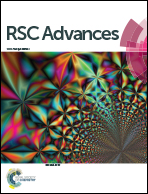Highly selective arylhydrazone based “ON–OFF” fluorescent chemosensors for Zn2+ ion, inhibitors for KB cell, 4LRH cancer protein and DFT studies†
Abstract
The synthesis of hydrazone-based chemosensor assemblies for zinc is detailed in this report using established and simple synthetic pathways. The coordination properties and photo physical response of new, easy-to-prepare and highly selective 2-(2-(4-fluoro-2-nitrophenyl)hydrazono)-5,5-dimethylcyclohexane-1,3-dione (1), (E)-5,5-dimethyl-2-(2-(4-(phenyldiazenyl)phenyl)hydrazono)cyclohexane-1,3-dione (2) have been examined. The sensors were characterized by UV-vis, FT-IR, 1H NMR, 13C NMR, scanning electron microscopy (SEM) and fluorescence spectroscopy. New sensors exhibited higher selectivity for Zn2+ over other metal ions in an aqueous ethanol medium. The experimental results show the sensors are highly selective and sensitive towards Zn2+ in the presence of competing ions, even in lower concentrations with a detection limit of 3.5 μM (1) and 4.0 μM (2). Collective experimental and theoretical studies were carried out on the molecular structure using the density functional method (B3LYP) invoking the 6-31G basis set. From the theoretical studies the energies of the highest occupied molecular (HOMO) orbital and lowest unoccupied (LUMO) molecular orbital have been predicted. From the cytotoxic study, the ability of these compounds (1) and (2) to inhibit the growth of KB cell lines was examined. The chelating functionality of compound (1) and (2) was evaluated for their inhibitory properties against various cancer proteins like 4LRH, 4EKD, 4GIW and 4L9K.


 Please wait while we load your content...
Please wait while we load your content...